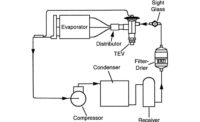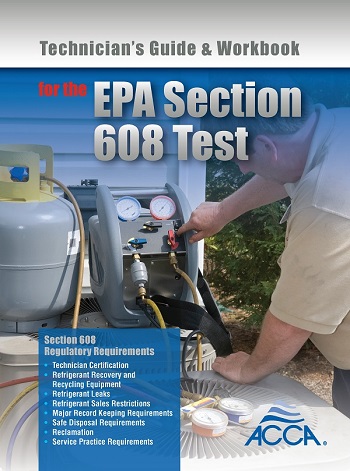To understand what a CO alarm is designed to do as far as protecting someone, consider a healthy adult male serving in the military. The reason you need to consider CO alarms from this perspective is because that is what many of the alarms on the market are fundamentally designed to do. In the event that the level of carbon monoxide in a building will begin to cause harm to a healthy adult male, most CO alarms will sound a warning. This, of course, raises the question, “So what about the other people in the household?” Not everybody is in the same physical condition. Children and infants, elderly people, women, or people with respiratory conditions aren’t of the same physical makeup of the adult male, which means that people who fit this profile will be affected by CO at a lower level.

A CO test device is shown being demonstrated at a technician training session.
With those facts about most CO alarms understood, consider the following listing of CO levels and recommendations regarding them:
009 ppm: Maximum allowable concentration for continuous 24-hour exposure.
10 to 35 ppm: Occupants should be advised of a potential health hazard, particularly to infants, small children, elderly people, and persons with respiratory or health problems.
35 ppm: Common action level for fire department and other emergency personnel to use SCBA (self contained breathing apparatus).
50 ppm: Maximum allowable concentration for workers’ continuous exposure in an 8-hour period.
70 ppm: Level required for UL 2034 alarms to sound when concentration is present for no more than 240 minutes, or as early as 60 minutes.
36 to 99 ppm: Medical alert. Ventilation required.
100 to 200 ppm: Dangerous, a commonly accepted building evacuation standard.
In addition to the list above, consider that some CO alarms won’t display a constant CO ppm reading until the unit goes into a full alarm. This means that the building occupants could be exposed to a CO concentration of 70 ppm or more for a minimum of 60 minutes, or possibly as long as 4 hours. This is especially interesting in consideration of protecting people when you note that 35 ppm is the action level at which emergency personnel will don SCBA equipment. Technicians need to be aware of the limits of some over-the-counter CO alarms on the market, and advise their high-risk customers accordingly. And then there’s the issue of the life of a sensor in a CO alarm.
Often, homeowners test their alarms by pushing a button and noting that the unit sounds a warning when they accomplish this test procedure. This only proves that the test button and the battery in the alarm are functioning. Sensors in CO alarms just don’t last forever, and that means that it’s possible that a unit that is as new as three-years-old may be useless in an actual emergency. Testing of a CO alarm should be accomplished by a technician using a test kit that simulates a concentration of carbon monoxide reaching the alarm. As far as installing a CO alarm properly, high on a wall or on the ceiling is the best location in a residence. Carbon monoxide has a specific gravity of 0.98 at 78°F, making it just slightly lighter than air, and that means that it will rise slowly to a higher location in the occupied space. Another factor to consider relative to locating a CO alarm is that it should be at least 8 feet from a gas appliance, such as gas range in a kitchen.
HEALTH EFFECTS OF CO POISONING
Technicians pursuing certification should also be aware of how CO affects the human body. When inhaled, it is absorbed into the bloodstream, displacing oxygen in the blood cells and forming what is known as Carboxyhemoglobin (COHb). When COHb is present, it displaces the oxygen delivered to the body, resulting in symptoms that are often misdiagnosed as other ailments. Often, a person thinks that they have the flu, when in fact they are under the effects of low-level carbon monoxide poisoning. In one emergency room test, 24 out of 100 people who were exhibiting flu-like symptoms were actually suffering from low-level carbon monoxide poisoning. Other signs and symptoms of CO poisoning are:• Headaches, both minor and severe
• Dizziness
• Fatigue
• Confusion
• Wheezing or bronchial congestion
• Persistent cough
As far as certain CO levels and their effects:
200 ppm: At this level of exposure, expect headaches, tiredness, dizziness, and nausea after two to three hours.
400 ppm: When this level of CO is present, it can be life threatening after three hours.
800 ppm: Dizziness, nausea, and convulsions within 45 minutes. Unconscious within two hours.
1,600 ppm: Headache, dizziness, and nausea within 20 minutes. Death within one hour.
From a simple perspective, technicians need to be aware that when a person is being poisoned by carbon monoxide, they can be drawing deep breaths, but in fact not be getting the oxygen their body requires. Since CO affects the ability of the blood to carry oxygen, the most effective way to determine whether or not a person has experienced exposure to a high level of CO is to do a blood test that measures COHb in a percentage. Some test equipment used to perform a combustion analysis on equipment can also be adapted to accomplish a breath test of a person suspected of being exposed to dangerous levels of carbon monoxide.
BUILDING PRESSURES AND CO
While HVACR technicians primarily focus on the condition of a furnace, inspecting the heat exchanger for cracks and checking the operation of the burners for proper combustion, they also need to be aware of the effect of building pressures and the possible backdrafting of gas appliances, even those appliances other than the furnace. Energy conservation and construction practices that make homes as tight as possible can result in a negative pressure in the building. Consider the idea that in every home there are appliances such as clothes dryers and kitchen exhaust fans that take air out of the building. Now, combine that understanding with the concept of a home sealed tightly during the heating season. When you put these two ideas together, and consider that a natural draft furnace or gas water heater depends on a slightly negative pressure in the vent to ensure that combustion gases leave the building, you can understand how backdrafting can occur.The closed-door effect is another concept relative to building pressures and possible backdrafting. In homes that use a central return on the gas furnace, closing a bedroom door will restrict the return airflow. The end result of this condition is that the air-handling system of the furnace will draw the return air from other areas of the home, causing them to depressurize, possibly allowing the backdrafting of atmospheric appliances such as natural draft furnaces or gas water heaters.
Another factor to consider relative to tightly sealed buildings is the unvented appliance, such as a gas range or certain space heaters. If this type of fuel-burning equipment is not properly adjusted, it can be responsible for the introduction of carbon monoxide in the structure, and a building that doesn’t have enough fresh air being introduced will allow it to linger at levels that may be dangerous for some occupants.
Proper installation and servicing of fuel-burning equipment is obviously a priority for HVACR technicians. And, an overall understanding of carbon monoxide, how it affects the health and well-being of people, what the limits of alarms are, and how building pressures can be a factor are just as important as knowing how to check the operation of the equipment.
Publication date:03/05/2007








